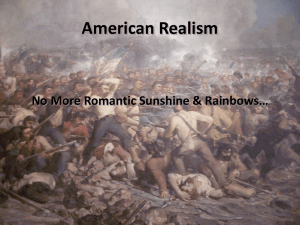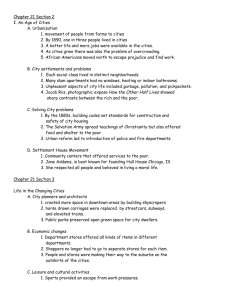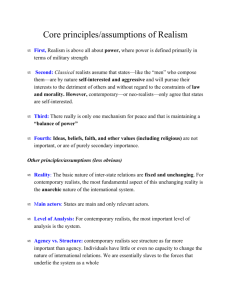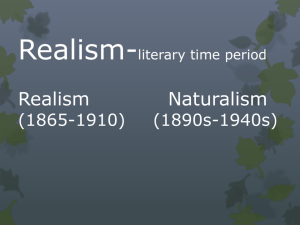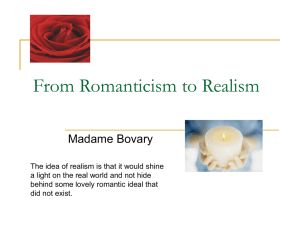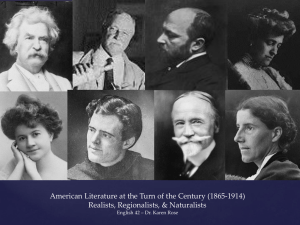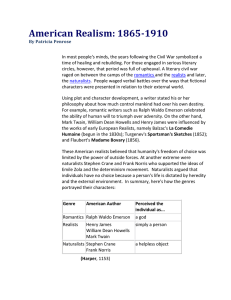american realism s15
advertisement
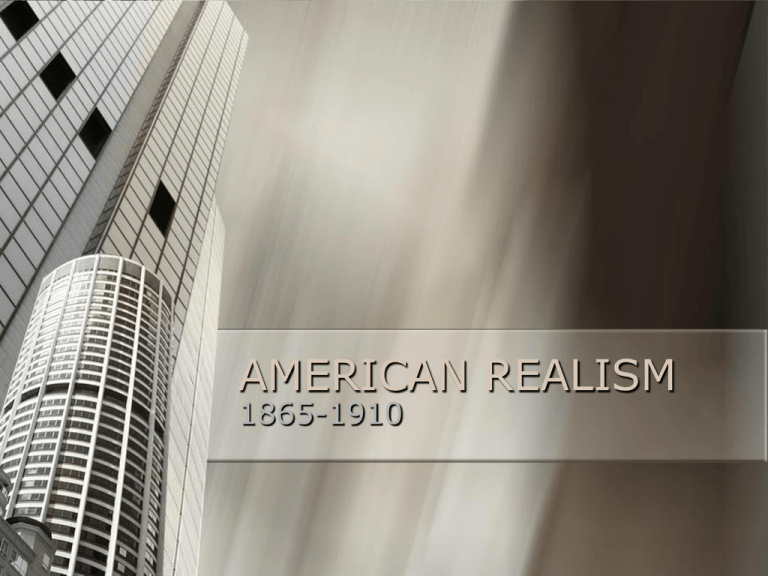
AMERICAN REALISM 1865-1910 Objectives/Goals for this Unit RL 11.1: Cite strong and thorough evidence to support analysis of what the text specifically says as well as inferences RI 11.2: Determine two or more central ideas of a text and analyze their development over a text. RL 11.3: Analyze the impact of the author’s choices regarding how to develop and relate elements of a story or drama (e.g., where a story is set, how the action is ordered, how the characters are introduced and developed). RL 11.6: Assess how point of view or purpose shapes the context and style of a text Objectives cont. RI 11.3: Analyze a complex set of ideas or sequence of events – and explain how specific individuals, ideas, or events interact and develop – cause/effect, definition?, problem/cause, etc. RI 11.6. Determine an author’s point of view or purpose in a text in which the rhetoric is effective. Analyze style and content for power, persuasion, and/or beauty. Lit Terms for Unit Author’s Point of view Purpose The author’s point of view is his feeling, opinion, or belief about his topic (different from narrator POV). The author’s purpose (a.k.a., author’s intent) is his reason for writing. - entertain, persuade, inform/educate, Central idea Author’s Choices Author’s Style The central idea is like a thesis statement in an essay; it is a statement of your main points. author's deliberate selection of stylistic devices in order to present his ideas author's style - the choices the author made regarding diction, syntax, tone, imagery, POV, etc. Diction Deliberate choice of words Syntax Sentence structure of a text. HISTORY The years following the Civil War symbolized a time of healing and rebuilding. In literary circles, however, this time period is full of upheaval and struggle. A literary civil war raged between the Romantics, the Realists, and the Naturalists. More History The industrial revolution took place at the end of the 19th century and changed the country in many ways. People left the country and went to the city to live. With new machinery and equipment, the economy focused on factories. Farming was no longer relied on so heavily. The immigration boom occurred. People worldwide flocked to the USA. Characteristics of Realism Literature Setting, Tone, and Motifs Characterization and Theme They drew on the grim realities of life in poor urban areas, bleak, despairing tones, and motifs about the breakdown of traditional values. characters were ordinary, everyday people. Plot was about everyday existence. Themes on the complexities of the human experience. Literary Wars Verbal wars were waged over the ways that fictional characters were presented in relation to their external world. Using plot and character development, a writer stated his/her philosophy about how much control mankind has over his destiny American Realists vs. American Naturalists American realists believed that humanity’s freedom of choice was limited by the power of outside forces. A person has choices and some freewill, but environment and others can hamper those choices American naturalists supported the determinism movement. They argued that individuals have no choice because a person’s life was dictated by heredity and the external environment. Realism vs. Naturalism Realism – stories present the world as it really is (like a photo) Plots drawn from details of everyday life and uses dialect Focus on central character (plain everyday people) who deals with a moral struggle Usually internal struggle Naturalism is outgrowth of Realism. Presents world like a photo and uses dialect Not as interested in individual struggle, but larger forces that control people (war, poverty, slavery,environment) More likely to deal with the extraordinary Grim tone HOW THE GENRES PORTRAYED THEIR CHARACTERS Romantics – a god Realists – simply a person Naturalists – a helpless object Regionalism Their writing was regional, emphasizing specific geographic settings and made use of the speech and manners of the people that live in that region. In the face of modernization, people feared the loss of traditions and folk ways, so writers set their stories in specific American regions.
